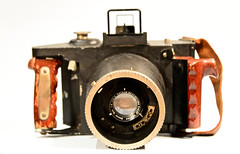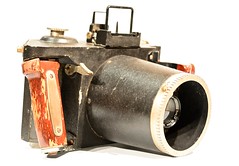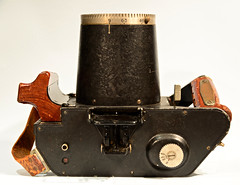Difference between revisions of "Japanese aerial cameras"
m (→Bibliography: nowiki round ISBN) |
m (→Links: Updated LPA links) |
||
| (55 intermediate revisions by 4 users not shown) | |||
| Line 3: | Line 3: | ||
== Handheld reconnaissance cameras == | == Handheld reconnaissance cameras == | ||
=== Nedinsco type === | === Nedinsco type === | ||
| − | The first aerial camera used by the Japanese air forces in some quantity was the [[Nedinsco]] FK I.<REF name="Wetwing Nedinsco"> [http://www.wetwing.com/aerialcamera/25cmcamera/25cmcamera.html 25cm Aerial Camera (Nedinsco type)] at Wetwing Aerial Camera. </REF> (Nedinsco was a Dutch branch of [[Carl Zeiss]], and "FK" perhaps means <u>F</u>lieger<u>k</u>amera.) It was adopted by the Japanese Army as the '''25cm Aerial Camera''' (二十五糎航空写真機),<REF name="Wetwing Nedinsco" /> named after its 25cm focal length. It was also used by the Navy as the '''Handheld Aerial Camera 25cm''' (手持式航空写真機二五糎).<REF name="Kore-nani Nedinsco"> [http://www.geocities.jp/kyo_oomiya/nhandcam.html Handheld Aerial Camera 25cm] at Kore Nāni. </REF> | + | The first aerial camera used by the Japanese air forces in some quantity was the [[Nedinsco]] FK I.<REF name="Wetwing Nedinsco"> [http://www.wetwing.com/aerialcamera/25cmcamera/25cmcamera.html 25cm Aerial Camera (Nedinsco type)] at Wetwing Aerial Camera. </REF> (Nedinsco was a Dutch branch of [[Carl Zeiss]], and "FK" perhaps means <u>F</u>lieger<u>k</u>amera.) It was adopted by the Japanese Army as the '''25cm Aerial Camera''' (二十五糎航空写真機),<REF name="Wetwing Nedinsco" /> named after its 25cm focal length. It was also used by the Navy as the '''Handheld Aerial Camera 25cm''' (手持式航空写真機二五糎).<REF name="Kore-nani Nedinsco"> [https://web.archive.org/web/20100721233452/http://www.geocities.jp/kyo_oomiya/nhandcam.html Handheld Aerial Camera 25cm] (archived) at Kore Nāni. </REF> |
The Nedinsco camera was later produced in Japan by [[Konica|Rokuoh-sha]],<REF name="Wetwing Nedinsco" /> perhaps after an official license was bought or as an unauthorized copy. Cameras made in the 1930s have a [[Hexar lenses|Hexar Ser.1 25cm f/4.5]] lens. They were mostly retired from use when the Pacific War broke out.<REF> ''Japanese Naval Photography'', p.12, where the camera is described as the "25cm Hand-Held Oblique Camera". </REF> | The Nedinsco camera was later produced in Japan by [[Konica|Rokuoh-sha]],<REF name="Wetwing Nedinsco" /> perhaps after an official license was bought or as an unauthorized copy. Cameras made in the 1930s have a [[Hexar lenses|Hexar Ser.1 25cm f/4.5]] lens. They were mostly retired from use when the Pacific War broke out.<REF> ''Japanese Naval Photography'', p.12, where the camera is described as the "25cm Hand-Held Oblique Camera". </REF> | ||
| Line 11: | Line 11: | ||
The focal-plane shutter is a separate unit, which can be slid out of the body for maintenance or repair. It has vertically travelling curtains, and the range of speeds is 1/90, 1/180, 1/375 and 1/750.<REF name="Wetwing Nedinsco" /><REF name="Kore-nani Nedinsco" /> | The focal-plane shutter is a separate unit, which can be slid out of the body for maintenance or repair. It has vertically travelling curtains, and the range of speeds is 1/90, 1/180, 1/375 and 1/750.<REF name="Wetwing Nedinsco" /><REF name="Kore-nani Nedinsco" /> | ||
| − | The aperture is set by an index at the top of the camera, in front of the identification plate, with f/4.5, f/6.3 and f/9 positions.<REF name="Kore-nani Nedinsco pictures"> Pictures in [http://www.geocities.jp/kyo_oomiya/nhandcam.html this page] at Kore Nāni. </REF> There is an articulated mechanism placed around the lens, holding two filters controlled by external knobs on either side of the body. | + | The aperture is set by an index at the top of the camera, in front of the identification plate, with f/4.5, f/6.3 and f/9 positions.<REF name="Kore-nani Nedinsco pictures"> Pictures in [https://web.archive.org/web/20100721233452/http://www.geocities.jp/kyo_oomiya/nhandcam.html this page] (archived) at Kore Nāni. </REF> There is an articulated mechanism placed around the lens, holding two filters controlled by external knobs on either side of the body. |
=== Navy Handheld Aerial Camera 25cm F-8 type === | === Navy Handheld Aerial Camera 25cm F-8 type === | ||
| Line 28: | Line 28: | ||
It is plausible that the F-8 type replaced the Nedinsco type as the standard hand-held camera in 13×18cm format for the Navy, and it seems reasonable to assume that the first examples were made in the mid to late 1930s. | It is plausible that the F-8 type replaced the Nedinsco type as the standard hand-held camera in 13×18cm format for the Navy, and it seems reasonable to assume that the first examples were made in the mid to late 1930s. | ||
| − | The F-8 type takes 13×18cm exposures. The 1945 American report says that the early examples were taking six glass plates within a magazine, but the camera was modified to use rollfilm "early in the war".<REF name="JNP p10 Airrecce"> ''Japanese Naval Photography'', p.10, repeated in [http://www.airrecce.co.uk/cameras/Jap_cameras.html this page] at Airrecce </REF> All the surviving examples known so far take 18cm wide film rolls.<REF name="Wetwing Aerial" /><REF name="Iwama p55" /> The rolls were normally 3.7m long, allowing for 25 frames,<REF name="Wetwing Aerial" /> but double-length 7.5m rolls were manufactured in 1943 and 1944.<REF name="JNP p18"> ''Japanese Naval Photography'', p.18. </REF><REF> Iwama, p.55 of {{KKS}} no.10, says 6m, but this is certainly a confusion with the 18cm × 6m rolls used in some Army cameras, see ''Japanese Naval Photography'', p.18. </REF> | + | The F-8 type takes 13×18cm exposures. The 1945 American report says that the early examples were taking six glass plates within a magazine, but the camera was modified to use rollfilm "early in the war".<REF name="JNP p10 Airrecce"> ''Japanese Naval Photography'', p.10, repeated in [https://web.archive.org/web/20170317162344/http://www.airrecce.co.uk/cameras/Jap_cameras.html this page] at Airrecce (archived) </REF> All the surviving examples known so far take 18cm wide film rolls.<REF name="Wetwing Aerial" /><REF name="Iwama p55" /> The rolls were normally 3.7m long, allowing for 25 frames,<REF name="Wetwing Aerial" /> but double-length 7.5m rolls were manufactured in 1943 and 1944.<REF name="JNP p18"> ''Japanese Naval Photography'', p.18. </REF><REF> Iwama, p.55 of {{KKS}} no.10, says 6m, but this is certainly a confusion with the 18cm × 6m rolls used in some Army cameras, see ''Japanese Naval Photography'', p.18. </REF> |
The camera body is made of metal. The shutter is of the focal-plane type, with 1/60, 1/100, 1/160, 1/200, 1/300 and 1/400 speeds.<REF name="Wetwing Aerial" /> When rotated, the right handle advances the film, winds the shutter and advances the exposure counter in a single movement.<REF name="Iwama p55" /> There is a folding frame finder at the top, of which variations are known. | The camera body is made of metal. The shutter is of the focal-plane type, with 1/60, 1/100, 1/160, 1/200, 1/300 and 1/400 speeds.<REF name="Wetwing Aerial" /> When rotated, the right handle advances the film, winds the shutter and advances the exposure counter in a single movement.<REF name="Iwama p55" /> There is a folding frame finder at the top, of which variations are known. | ||
| Line 34: | Line 34: | ||
If we accept the 1924 or 1925 release date given by some Japanese sources (see above), the early examples made until the early 1930s certainly had an imported German lens. The examples found today normally have a [[Hexar lenses|Hexar Ser.1 25cm f/4.5]] (same as mounted on the [[#Nedinsco type|Nedinsco type]]), sometimes with abbreviated markings ''Hexar.1 4.5 25''. | If we accept the 1924 or 1925 release date given by some Japanese sources (see above), the early examples made until the early 1930s certainly had an imported German lens. The examples found today normally have a [[Hexar lenses|Hexar Ser.1 25cm f/4.5]] (same as mounted on the [[#Nedinsco type|Nedinsco type]]), sometimes with abbreviated markings ''Hexar.1 4.5 25''. | ||
| − | Surviving examples have been observed in two main variants. The '''first variant'''<REF> Examples pictured in [ | + | Surviving examples have been observed in two main variants. The '''first variant'''<REF> Examples pictured in [https://www.worthpoint.com/worthopedia/wwii-japanese-aerial-camera-5x7-konishiroku-25cm this WorthPoint entry] (with Rokuoh-sha Tokyo Hexar Ser.1 25cm f/4.5 lens no.5382), and in [http://www.wetwing.com/aerialcamera/aerialcameras/cameras.html this page] and [http://www.wetwing.com/aerialcamera/index.html this page] at Wetwing Aerial Camera (with serial no.1176). </REF> has a large black identification plate, with the camera's official name in Japanese characters (手持手持式航空寫眞機25cm F-8型), a serial number, the year and month of manufacture, and the words Tokyo (東京) and Rokuoh-sha (六櫻社). There is a small housing on the left side, behind the left handle. There is no control lever above the camera, and the aperture is perhaps directly controlled by turning a ring around the lens. Finally, there are four screw threads at the front of the main body, probably provided to attach the camera to a fixed aircraft mount. The December 1945 American report says that attempts were made to use the F-8 type as a vertical camera, and about 25 mounts were produced for the C6N Saiun (Myrt) reconnaissance plane, but the trials were not satisfactory and the camera was only used hand-held.<REF name="JNP p10 Airrecce" /> |
| − | The '''second variant'''<REF> Examples pictured in [http://www.airrecce.co.uk/cameras/Jap_cameras.html this page] at Airrecce, and in [ | + | The '''second variant'''<REF> Examples pictured in [https://web.archive.org/web/20170317162344/http://www.airrecce.co.uk/cameras/Jap_cameras.html this page] (archived) at Airrecce, and in [https://web.archive.org/web/20160523063442/https://airandspace.si.edu/collections/artifact.cfm?id=A19711014000 F-8 this page] (archived) of the NASM. </REF> is presumably later. It has a small white plate with Rokuoh-sha or Konishiroku's logo (the character ''roku'' 六 inside a stylized cherry blossom) and a serial number. Two levers are visible at the top, in front of the frame finder. The front lever controls the aperture and has three positions: 4.5, 6.3 and 9. The second lever was used to compensate for proper focus with infra-red film.<REF name="JNP p10 Airrecce" /> The small housing on the left side and the four screw threads at the front are no longer present. |
=== Army Type 96 Small Aerial Camera === | === Army Type 96 Small Aerial Camera === | ||
| Line 56: | Line 56: | ||
The total production was surely higher, if one takes into account the cameras made by Fuji. | The total production was surely higher, if one takes into account the cameras made by Fuji. | ||
| − | The camera is loaded with 9cm wide<REF name="JNP p8" /> perforated film rolls. The picture format is about 7.5×10cm.<REF> Iwama, p.54 of {{KKS}} no.10, [http://www.wetwing.com/aerialcamera/aerialcameras/cameras.html this page] at Wetwing Aerial Camera, and ''Japanese Naval Photography'', p.11, all say 7.5×10cm. [http://www.geocities.jp/kyo_oomiya/99cam.html This page] at Kore Nāni says 70×100mm, and {{SUG}}, item 6010, says 72×98mm. </REF> The film strips are 2.3 metres in length,<REF name="JNP p8" /><REF name="JNP p18" /> allowing for 20 exposures.<REF> The camera pictured in [http://www.geocities.jp/kyo_oomiya/99cam.html this page] at Kore Nāni clearly shows an exposure counter graduated from 1 to 20. ''Japanese Naval Photography'', p.11, repeated in [http://www.airrecce.co.uk/cameras/Jap_cameras.html this page] at Airrecce, also mentions 20 exposures. [http://www.wetwing.com/aerialcamera/aerialcameras/cameras.html This page] at Wetwing Aerial Camera, mentions 6 or 10-exposure film strips, perhaps by mistake. {{SUG}}, item 6010, says that the camera takes glass plates and sheetfilm, but this is obviously a mistake. </REF> | + | The camera is loaded with 9cm wide<REF name="JNP p8" /> perforated film rolls. The picture format is about 7.5×10cm.<REF> Iwama, p.54 of {{KKS}} no.10, [http://www.wetwing.com/aerialcamera/aerialcameras/cameras.html this page] at Wetwing Aerial Camera, and ''Japanese Naval Photography'', p.11, all say 7.5×10cm. [https://web.archive.org/web/20190330172757/http://www.geocities.jp/kyo_oomiya/99cam.html This page] (archived) at Kore Nāni says 70×100mm, and {{SUG}}, item 6010, says 72×98mm. </REF> The film strips are 2.3 metres in length,<REF name="JNP p8" /><REF name="JNP p18" /> allowing for 20 exposures.<REF> The camera pictured in [https://web.archive.org/web/20190330172757/http://www.geocities.jp/kyo_oomiya/99cam.html this page] (archived) at Kore Nāni clearly shows an exposure counter graduated from 1 to 20. ''Japanese Naval Photography'', p.11, repeated in [https://web.archive.org/web/20170317162344/http://www.airrecce.co.uk/cameras/Jap_cameras.html this page] (archived) at Airrecce, also mentions 20 exposures. [http://www.wetwing.com/aerialcamera/aerialcameras/cameras.html This page] at Wetwing Aerial Camera, mentions 6 or 10-exposure film strips, perhaps by mistake. {{SUG}}, item 6010, says that the camera takes glass plates and sheetfilm, but this is obviously a mistake. </REF> |
| − | The camera has a folding frame finder at the top, and wooden handles on both sides of the body. The shutter is of the focal-plane type, with horizontally running curtains. It normally gives 1/75, 1/150, 1/250 and 1/400 speeds,<REF> [http://www.geocities.jp/kyo_oomiya/99cam.html This page] at Kore Nāni, and specifications in {{SUG}}, item 6010. </REF> selected by a wheel at the top. (The American report mentions 1/25 to 1/500 speeds, perhaps by mistake.)<REF> ''Japanese Naval Photography'', p.11, repeated in [http://www.airrecce.co.uk/cameras/Jap_cameras.html this page] at Airrecce. </REF> The main release has the shape of a trigger, actioned by the right index. The film is advanced and the shutter is wound by turning the right-hand handle by 90 degrees twice.<REF> [http://www.geocities.jp/kyo_oomiya/99cam.html This page] at Kore Nāni. </REF><REF name="Wetwing Aerial" /> The camera has an automatic exposure counter, either at the top left or to the right of the viewfinder.<REF> Compare the two examples pictured in Iwama, p.54 of {{KKS}} no.10. </REF> The back is fully removable and is locked by two keys, with open (開) and close (閉) indications. | + | The camera has a folding frame finder at the top, and wooden handles on both sides of the body. The shutter is of the focal-plane type, with horizontally running curtains. It normally gives 1/75, 1/150, 1/250 and 1/400 speeds,<REF> [https://web.archive.org/web/20190330172757/http://www.geocities.jp/kyo_oomiya/99cam.html This page] (archived) at Kore Nāni, and specifications in {{SUG}}, item 6010. </REF> selected by a wheel at the top. (The American report mentions 1/25 to 1/500 speeds, perhaps by mistake.)<REF> ''Japanese Naval Photography'', p.11, repeated in [https://web.archive.org/web/20170317162344/http://www.airrecce.co.uk/cameras/Jap_cameras.html this page] (archived) at Airrecce. </REF> The main release has the shape of a trigger, actioned by the right index. The film is advanced and the shutter is wound by turning the right-hand handle by 90 degrees twice.<REF> [https://web.archive.org/web/20190330172757/http://www.geocities.jp/kyo_oomiya/99cam.html This page] (archived) at Kore Nāni. </REF><REF name="Wetwing Aerial" /> The camera has an automatic exposure counter, either at the top left or to the right of the viewfinder.<REF> Compare the two examples pictured in Iwama, p.54 of {{KKS}} no.10. </REF> The back is fully removable and is locked by two keys, with open (開) and close (閉) indications. |
It is said that two versions were made, one for aerial use only and the other for both aerial and terrestrial use. Variations have been observed in the surviving camera bodies, which are described [[Type 99 Handheld Aerial Camera | in the specific entry on the camera]]. | It is said that two versions were made, one for aerial use only and the other for both aerial and terrestrial use. Variations have been observed in the surviving camera bodies, which are described [[Type 99 Handheld Aerial Camera | in the specific entry on the camera]]. | ||
| Line 107: | Line 107: | ||
{| class="plainlinks" align="center" style="text-align: center;" | {| class="plainlinks" align="center" style="text-align: center;" | ||
|- | |- | ||
| − | || [http://www.flickr.com/photos/heritagefutures/4648910067/in/pool-camerawiki http://farm5.static.flickr.com/4034/4648910067_daa3735590_m.jpg] [http://www.flickr.com/photos/heritagefutures/4648912081/in/pool-camerawiki http://farm4.static.flickr.com/3399/4648912081_48576873b5_m.jpg] [http://www.flickr.com/photos/heritagefutures/4648910545/in/pool-camerawiki http://farm5.static.flickr.com/4012/4648910545_6f4a338824_m.jpg] [http://www.flickr.com/photos/heritagefutures/4649531250/in/pool-camerawiki http://farm5.static.flickr.com/4007/4649531250_d0f4b5b4ba_m.jpg] | + | || [http://www.flickr.com/photos/heritagefutures/4648910067/in/pool-camerawiki http://farm5.static.flickr.com/4034/4648910067_daa3735590_m.jpg] [http://www.flickr.com/photos/heritagefutures/4648912081/in/pool-camerawiki http://farm4.static.flickr.com/3399/4648912081_48576873b5_m.jpg] [http://www.flickr.com/photos/heritagefutures/4648910545/in/pool-camerawiki http://farm5.static.flickr.com/4012/4648910545_6f4a338824_m.jpg] [http://www.flickr.com/photos/heritagefutures/4649531250/in/pool-camerawiki http://farm5.static.flickr.com/4007/4649531250_d0f4b5b4ba_m.jpg] [https://www.flickr.com/photos/heritagefutures/7655743654/in/pool-camerawiki http://farm9.staticflickr.com/8430/7655743654_d4e59037f3_m.jpg] |
|- | |- | ||
|| ''[[Konica|Konishiroku]]-built Army Type 99 Ultra Small Aerial Camera ([[GSK-99]]).''<br>''Pictures by {{image author|Dirk HR Spennemann}}. {{With permission}}'' | || ''[[Konica|Konishiroku]]-built Army Type 99 Ultra Small Aerial Camera ([[GSK-99]]).''<br>''Pictures by {{image author|Dirk HR Spennemann}}. {{With permission}}'' | ||
| Line 121: | Line 121: | ||
|| Delivered || 30 || 306 || 1456 || 2212 || 265 || 4269 | || Delivered || 30 || 306 || 1456 || 2212 || 265 || 4269 | ||
|} | |} | ||
| − | At least some SK-100 cameras were also produced by Chiyoda Kōgaku<REF name="SUG 6013"> {{SUG}}, item 6013. </REF> (predecessor of [[Minolta]]) or by [[Katsura|Katsura Seisakusho]].<REF name="Topcon Club SK-100"> [http:// | + | At least some SK-100 cameras were also produced by Chiyoda Kōgaku<REF name="SUG 6013"> {{SUG}}, item 6013. </REF> (predecessor of [[Minolta]]) or by [[Katsura|Katsura Seisakusho]].<REF name="Topcon Club SK-100"> [http://www.topgabacho.jp/Topconclub/another.htm This page] of the Topcon Club. </REF> Some sources insist in attributing the SK-100 to Chiyoda altogether, but it rather seems that the camera was developed by [[Konica|Konishiroku]],<REF name="Wetwing Aerial" /> drawing on its longer experience of aerial cameras, and that the other manufacturers played a secondary role. |
The SK-100 takes fourty 11.5×16cm pictures<REF name="KKS12 p18"> {{KKS}} no.12, p.18. </REF><REF name="Francesch SK100"> Francesch, p.253. </REF> on special rollfilm, 18cm wide and 6m long.<REF name="JNP p9"> ''Japanese Naval Photography'', p.9. </REF> The camera is much larger than the [[GSK-99]] — its dimensions are 38×29×35cm, and it weighs 6.9kg.<REF name="KKS12 p18" /> There is a built-in focal-plane shutter, giving 1/200, 1/300 and 1/400 speeds.<REF name="KKS12 p18" /><REF name="Francesch SK100" /><REF name="SUG 6013" /> | The SK-100 takes fourty 11.5×16cm pictures<REF name="KKS12 p18"> {{KKS}} no.12, p.18. </REF><REF name="Francesch SK100"> Francesch, p.253. </REF> on special rollfilm, 18cm wide and 6m long.<REF name="JNP p9"> ''Japanese Naval Photography'', p.9. </REF> The camera is much larger than the [[GSK-99]] — its dimensions are 38×29×35cm, and it weighs 6.9kg.<REF name="KKS12 p18" /> There is a built-in focal-plane shutter, giving 1/200, 1/300 and 1/400 speeds.<REF name="KKS12 p18" /><REF name="Francesch SK100" /><REF name="SUG 6013" /> | ||
| − | The camera has a folding frame finder at the top, and large handles on both sides of the body. There is a retractable bubble level, for vertical photography.<REF name="Kore-nani SK-100 pictures"> Pictures in [http://www.geocities.jp/kyo_oomiya/nhandcam.html Type 100 Small Aerial Camera] at Kore Nāni. </REF> The main release is a trigger, falling under the right-hand index. | + | The camera has a folding frame finder at the top, and large handles on both sides of the body. There is a retractable bubble level, for vertical photography.<REF name="Kore-nani SK-100 pictures"> Pictures in [https://web.archive.org/web/20100721233452/http://www.geocities.jp/kyo_oomiya/nhandcam.html Type 100 Small Aerial Camera] (archived) at Kore Nāni. </REF> The main release is a trigger, falling under the right-hand index. |
| − | The shutter is of the focal-plane type, with vertically running curtains. It gives 1/200, 1/300 and 1/400 speeds,<REF name="KKS12 p18" /><REF name="Francesch SK100" /><REF name="SUG 6013" /> set by a small button placed at the bottom right of the camera. On some cameras, the selected speed is displayed in a small window on the rear, behind this button, with the indication 露出速度 ("exposure speed").<REF name="Kore-nani SK-100 pictures" /> The slit between the two shutter curtains has a fixed width, and the speed button actually modifies the tension of the main springs.<REF name="Kore-nani SK-100"> [http://www.geocities.jp/kyo_oomiya/nhandcam.html Type 100 Small Aerial Camera] at Kore Nāni. </REF> It is said that the slit is constantly open, and that a light shield is raised behind the lens after each exposure, in order not to fog the film.<REF name="Topcon Club SK-100" /> | + | The shutter is of the focal-plane type, with vertically running curtains. It gives 1/200, 1/300 and 1/400 speeds,<REF name="KKS12 p18" /><REF name="Francesch SK100" /><REF name="SUG 6013" /> set by a small button placed at the bottom right of the camera. On some cameras, the selected speed is displayed in a small window on the rear, behind this button, with the indication 露出速度 ("exposure speed").<REF name="Kore-nani SK-100 pictures" /> The slit between the two shutter curtains has a fixed width, and the speed button actually modifies the tension of the main springs.<REF name="Kore-nani SK-100"> [https://web.archive.org/web/20100721233452/http://www.geocities.jp/kyo_oomiya/nhandcam.html Type 100 Small Aerial Camera] (archived) at Kore Nāni. </REF> It is said that the slit is constantly open, and that a light shield is raised behind the lens after each exposure, in order not to fog the film.<REF name="Topcon Club SK-100" /> |
The camera's back is removable for film loading. The supply spool is inserted at the bottom, and the film runs from bottom to top.<REF name="Kore-nani SK-100" /> There is a glass plate inside the exposure chamber, behind the shutter curtains, to improve the film flatness. The film is advanced and the shutter is wound by turning a large knob on the right. The frame number is displayed on the rear, behind the knob, sometimes with the indication 撮影枚數 ("frame number").<REF name="Kore-nani SK-100 pictures" /> | The camera's back is removable for film loading. The supply spool is inserted at the bottom, and the film runs from bottom to top.<REF name="Kore-nani SK-100" /> There is a glass plate inside the exposure chamber, behind the shutter curtains, to improve the film flatness. The film is advanced and the shutter is wound by turning a large knob on the right. The frame number is displayed on the rear, behind the knob, sometimes with the indication 撮影枚數 ("frame number").<REF name="Kore-nani SK-100 pictures" /> | ||
| Line 135: | Line 135: | ||
{| class="plainlinks" align="center" style="text-align: center;" | {| class="plainlinks" align="center" style="text-align: center;" | ||
|- | |- | ||
| − | || [http://www.flickr.com/photos/ | + | || [http://www.flickr.com/photos/camerawiki/31556597667/in/pool-camerawiki http://farm8.staticflickr.com/7851/31556597667_816e2b222b.jpg] |
|- | |- | ||
|| ''Army Type 100 Small Aerial Camera (SK-100), with [[Hexar lenses|Hexar Ser.IIA]] 20cm f/3.5 no.4203.<br>The other lenses are Simlar 180.2mm and 179.5mm f/4.5, Tele-Hexar and Boen Rokkor 40cm f/5.6.<br>Picture by eBayer Hbpartner. {{with permission}}'' | || ''Army Type 100 Small Aerial Camera (SK-100), with [[Hexar lenses|Hexar Ser.IIA]] 20cm f/3.5 no.4203.<br>The other lenses are Simlar 180.2mm and 179.5mm f/4.5, Tele-Hexar and Boen Rokkor 40cm f/5.6.<br>Picture by eBayer Hbpartner. {{with permission}}'' | ||
| Line 143: | Line 143: | ||
{| class="plainlinks" align="center" style="text-align: center;" | {| class="plainlinks" align="center" style="text-align: center;" | ||
| − | || [http://www.flickr.com/photos/ | + | || [http://www.flickr.com/photos/camerawiki/46445334102/in/pool-camerawiki http://farm5.staticflickr.com/4915/46445334102_6928374952_m.jpg] [http://www.flickr.com/photos/camerawiki/45583708665/in/pool-camerawiki http://farm5.staticflickr.com/4917/45583708665_e7b8475972_m.jpg] |
|- | |- | ||
|| ''Tele-Hexar 40cm f/5.6 lens no.4046 and Boen Rokkor 40cm f/5.6 no.78, for SK-100.<br>Pictures by eBayer Hbpartner. {{with permission}}'' | || ''Tele-Hexar 40cm f/5.6 lens no.4046 and Boen Rokkor 40cm f/5.6 no.78, for SK-100.<br>Pictures by eBayer Hbpartner. {{with permission}}'' | ||
| Line 174: | Line 174: | ||
The camera takes 18×24cm pictures<REF name="JNP p10"> ''Japanese Naval Photography'', p.10. </REF><REF name="Iwama p55" /> on film rolls 24cm wide and 24m long,<REF name="JNP p18" /> allowing for 100 exposures<REF name="Iwama p55" /> and loaded in interchangeable magazine backs. It is equipped with a leaf shutter. The camera is remotely controlled and needs 12V electrical power supply.<REF name="JNP p9" /> | The camera takes 18×24cm pictures<REF name="JNP p10"> ''Japanese Naval Photography'', p.10. </REF><REF name="Iwama p55" /> on film rolls 24cm wide and 24m long,<REF name="JNP p18" /> allowing for 100 exposures<REF name="Iwama p55" /> and loaded in interchangeable magazine backs. It is equipped with a leaf shutter. The camera is remotely controlled and needs 12V electrical power supply.<REF name="JNP p9" /> | ||
| − | The camera was available in two main versions, differing by the lens unit. One has a 50cm f/5 lens (presumably a [[Hexar lenses|Hexar]]) and 1/50 to 1/100 speeds, for vertical pictures taken at altitudes from 20,000 to 30,000 feet.<REF name="JNP p9" /> The other has a Perigon<REF name="Iwama p55" /><REF> Example pictured in [http://www.nasm.si.edu/collections/artifact.cfm?id=A19603010000 this page] of the NASM. </REF> 25cm f/4.5 and 1/50 to 1/150 speeds, for use at altitudes from 13,000 to 23,000 feet.<REF name="JNP p10" /> (The name Perigon certainly indicates that this is a wide field lens.) Both versions were used in the C6N Saiun (Myrt) reconnaissance plane.<REF name="JNP p9" /><REF name="JNP p10" /> A special mount grouping together three 25cm K-8 at vertical and oblique angles was tested but apparently not operationally used.<REF name="JNP p10" /> | + | The camera was available in two main versions, differing by the lens unit. One has a 50cm f/5 lens (presumably a [[Hexar lenses|Hexar]]) and 1/50 to 1/100 speeds, for vertical pictures taken at altitudes from 20,000 to 30,000 feet.<REF name="JNP p9" /> The other has a Perigon<REF name="Iwama p55" /><REF> Example pictured in [https://web.archive.org/web/20110402224625/http://www.nasm.si.edu/collections/artifact.cfm?id=A19603010000 this page] (archived) of the NASM. </REF> 25cm f/4.5 and 1/50 to 1/150 speeds, for use at altitudes from 13,000 to 23,000 feet.<REF name="JNP p10" /> (The name Perigon certainly indicates that this is a wide field lens.) Both versions were used in the C6N Saiun (Myrt) reconnaissance plane.<REF name="JNP p9" /><REF name="JNP p10" /> A special mount grouping together three 25cm K-8 at vertical and oblique angles was tested but apparently not operationally used.<REF name="JNP p10" /> |
| − | The complete 50cm K-8 set consists of the main camera with lens unit and film magazine, two spare magazines, two intervalometers, an optical sight and a repair kit.<REF name="JNP p9" /><REF> A full set is pictured in Iwama, p.55 of {{KKS}} no.10. </REF> Various outfits are pictured in the 1945 American report cited above,<REF> ''Japanese Naval Photography'', pp.57–60. </REF> and a 25cm K-8 with Perigon lens and airframe mount is displayed at the Smithsonian National Air and Space Museum.<REF> [http://www.nasm.si.edu/collections/artifact.cfm?id=A19603010000 | + | The complete 50cm K-8 set consists of the main camera with lens unit and film magazine, two spare magazines, two intervalometers, an optical sight and a repair kit.<REF name="JNP p9" /><REF> A full set is pictured in Iwama, p.55 of {{KKS}} no.10. </REF> Various outfits are pictured in the 1945 American report cited above,<REF> ''Japanese Naval Photography'', pp.57–60. </REF> and a 25cm K-8 with Perigon lens and airframe mount is displayed at the Smithsonian National Air and Space Museum.<REF> [https://web.archive.org/web/20110402224625/http://www.nasm.si.edu/collections/artifact.cfm?id=A19603010000 this page] (archived) and [https://web.archive.org/web/20110402224705/http://www.nasm.si.edu/collections/artifact.cfm?id=A19603010001 this page] (archived) of the NASM. </REF> |
=== Army No.1 Automatic Aerial Camera 25cm === | === Army No.1 Automatic Aerial Camera 25cm === | ||
| Line 185: | Line 185: | ||
== Machine-gun training cameras == | == Machine-gun training cameras == | ||
| − | + | {{Flickr_image | |
| + | |image_source= https://www.flickr.com/photos/heritagefutures/7443711110/in/pool-camerawiki | ||
| + | |image= http://farm9.staticflickr.com/8163/7443711110_20fd8775da.jpg | ||
| + | |image_align= left | ||
| + | |image_text= Top: Katsura Seisakusho Machine Gun Training Camera<br/>bottom: Rokuoh Sha Type 89 Machine Gun Training Camera | ||
| + | |image_by= Dirk HR Spennemann | ||
| + | |image_rights= wp | ||
| + | }} | ||
| + | Machine-gun training cameras are shaped as a machine gun, and are used to train the gunners. [[Konica|Rokuoh-sha]] made various such cameras from the mid-1920s onwards, and [[Tōkyō Kōgaku]] made at least one model in the late 1930s. These "machine guns" shot photos of targets instead of shooting bullets onto the targets for documentation of a new machine gunner's training success. | ||
| + | {{br}} | ||
=== Navy Type 15 Gun Camera === | === Navy Type 15 Gun Camera === | ||
| − | The '''Type 15 Gun Camera with Watch''' (一五式写真銃時計附)<REF name="SUG 6014"> {{SUG}}, item 6014. </REF><REF name="nakayama type 15"> Nakayama and Imai, pp.126–7 of ''Militarī gun'yō kamera daizukan''. </REF> was made by [[Konica|Rokuoh-sha]] for the Navy, and the '''Type 15 Gun Camera Modified 1''' (一五式写真銃改一)<REF name="hexar0"> [http://www2f.biglobe.ne.jp/~ter-1212/sakura/hexar0.htm This page at R.Konishi Rokuoh-sha]. </REF> was certainly an evolution. | + | The '''Type 15 Gun Camera with Watch''' (一五式写真銃時計附)<REF name="SUG 6014"> {{SUG}}, item 6014. </REF><REF name="nakayama type 15"> Nakayama and Imai, pp.126–7 of ''Militarī gun'yō kamera daizukan''. </REF> was made by [[Konica|Rokuoh-sha]] for the Navy, and the '''Type 15 Gun Camera Modified 1''' (一五式写真銃改一)<REF name="hexar0"> [http://www2f.biglobe.ne.jp/~ter-1212/sakura/hexar0.htm This page at R.Konishi Rokuoh-sha]. The page mentions a batch of four, followed by another batch of ten, but there were surely others. </REF> was certainly an evolution. |
This machine-gun camera was ordered in May 1925 by Yamada Kōgorō (山田幸五郎) of the Japanese Navy, was produced from 1926 under the supervision of Mōri Hirō (毛利広雄), and delivered from 1927.<REF name="hexar0" /> It was inspired by the Hythe gun camera made by [[Thornton-Pickard]] in Great-Britain from 1915,<REF name="SUG 6014" /><REF name="hexar0" /> itself based on the Lewis machine gun. The Japanese copy was initially equipped with [[Wollensak]] or [[Zeiss]] [[Tessar]] lenses.<REF name="hexar0" /> It is said that it was produced until 1942,<REF name="hexar0" /> certainly switching to Japanese lenses at some point. | This machine-gun camera was ordered in May 1925 by Yamada Kōgorō (山田幸五郎) of the Japanese Navy, was produced from 1926 under the supervision of Mōri Hirō (毛利広雄), and delivered from 1927.<REF name="hexar0" /> It was inspired by the Hythe gun camera made by [[Thornton-Pickard]] in Great-Britain from 1915,<REF name="SUG 6014" /><REF name="hexar0" /> itself based on the Lewis machine gun. The Japanese copy was initially equipped with [[Wollensak]] or [[Zeiss]] [[Tessar]] lenses.<REF name="hexar0" /> It is said that it was produced until 1942,<REF name="hexar0" /> certainly switching to Japanese lenses at some point. | ||
| Line 195: | Line 204: | ||
=== Army Revolving Target-checking Camera === | === Army Revolving Target-checking Camera === | ||
| − | The '''Revolving Target-checking Camera''' (廻転式射撃鑑査写真機) was a similar camera made by [[Konica|Rokuoh-sha]] for the Army.<REF name="SUG 6018"> {{SUG}}, item 6018. </REF><REF name="hexar0" /> (In the name, the word "revolving" either refers to the drum magazine mounted at the top or to the fact that the camera was mounted on a turret.) The camera was also called "Hythe type" (ハイス型),<REF> Label inside the original box, observed in a picture posted at a forum. </REF> after the original Hythe | + | The '''Revolving Target-checking Camera''' (廻転式射撃鑑査写真機) was a similar camera made by [[Konica|Rokuoh-sha]] for the Army.<REF name="SUG 6018"> {{SUG}}, item 6018. </REF><REF name="hexar0" /> (In the name, the word "revolving" either refers to the drum magazine mounted at the top or to the fact that the camera was mounted on a turret.) The camera was also called "Hythe type" (ハイス型),<REF> Label inside the original box, observed in a picture posted at a forum. </REF> after the original Thornton-Pickard's [[Mk. III Hythe Camera Gun]] of 1916 of which it was a copy.<REF> Iwama, p.54 of {{KKS}} no.10, mentions a "Hythe model Target-checking Camera" (ハイス型射撃鑑査写真機) for the Navy. This is probably a confusion between the Army's Revolving Target-checking Camera and the Navy's Type 15 Gun Camera. </REF> It has almost the dimensions of a Japanese type 92 machine gun for calibre 7.7mm,<ref>see pinterest [https://s-media-cache-ak0.pinimg.com/564x/78/ad/1d/78ad1dbb033142d4e67275398a516421.jpg museum picture] and [https://www.pinterest.de/pin/37647346864745577/ WWII picture]</ref> |
| − | This model was perhaps released around 1926, at the same time as the Type 15 for the Navy. The image size is 4.5×6cm on [[120 film]],<REF name="SUG 6018" /> and there is no time recording device. It is said that the early cameras have [[Wollensak]] or [[Zeiss]] [[Tessar]] lenses.<REF name="hexar0" /> Later ones have an [[Zion and Optor|Optor]] 28.5cm f/11 lens.<REF name="SUG 6018" /><REF> Example pictured in [ | + | This model was perhaps released around 1926, at the same time as the Type 15 for the Navy. The image size is 4.5×6cm on [[120 film]],<REF name="SUG 6018" /> and there is no time recording device. It is said that the early cameras have [[Wollensak]] or [[Zeiss]] [[Tessar]] lenses.<REF name="hexar0" /> Later ones have an [[Zion and Optor|Optor]] or Topcon Toko 28.5cm f/11 lens.<REF name="SUG 6018" /><REF> Example pictured in [https://web.archive.org/web/20140217002446/https://www.seawood.com/classic-camera-corner/004-machine_gun_cameras/index.html this page] (archived) at Seawood Photo. </REF> |
| − | The same camera was also made by [[Tōkyō Kōgaku]], which supplied | + | The same camera was also made by [[Katsura]] (see image) as well as [[Tōkyō Kōgaku]], which supplied almost 900 units to the Japanese Army.<REF> {{SUG}} (item 6016_ notes 605 units, but recorded serial numbers go as high as 892.</REF> The version made by this company is called "Model 17" in some recent sources, but this is perhaps a confusion with the serial number of a surviving camera.<REF> The camera is called "Model 17" in {{SUG}}, item 6016, but the Japanese text actually corresponds to a serial number (第十七号), certainly that of the pictured example. Antonetto and Russo, pp.25 and 196, repeat the name "model 17", certainly after {{SUG}}; they say that this was a "rapid-firing camera capable of shooting a burst of 4.5×6cm frames", but this is unconfirmed. </REF> One source mentions a 387.5mm f/11 fixed-focus lens, but the focal length is perhaps wrong.<REF> Antonetto and Russo, p.196. </REF> |
=== Navy Type 89 Machine-gun Camera === | === Navy Type 89 Machine-gun Camera === | ||
| − | The '''Type 89 Moving-image Machine-gun Camera''' (八九式活動写真銃) was an all new model by [[Konica|Rokuoh-sha]]. It is said that four experimental cameras were made in 1929.<REF name="hexar0" /> (In the name, "Type 89" stands for year 2589 in the Japanese mythological calendar, i.e. 1929.) That early version perhaps had imported lenses. The improved '''Type 89 Moving-image Machine-gun Camera Kai''' (八九式活動写真銃改) or "Kai 1" (改一) followed in 1931 with [[Hexar lenses]].<REF name="hexar0" | + | The '''Type 89 Moving-image Machine-gun Camera''' (八九式活動写真銃) was an all new model by [[Konica|Rokuoh-sha]]. It is said that four experimental cameras were made in 1929.<REF name="hexar0" /> (In the name, "Type 89" stands for year 2589 in the Japanese mythological calendar, i.e. 1929.) That early version perhaps had imported lenses. The improved '''Type 89 Moving-image Machine-gun Camera Kai''' (八九式活動写真銃改) or "Kai 1" (改一) followed in 1931 with [[Hexar lenses]].<REF name="hexar0" /> The final version was the '''Kai 2''' (改二), serial produced from 1933 to about 1944.<REF name="hexar0" /> The camera was used by the Navy,<REF name="SUG 6015"> {{SUG}}, item 6015. </REF> as indicated by the anchor usually stamped on the nameplate.<ref>Many of these cameras were acquired by U.S. soldiers in Japan and consequently they are quite frequently offered in on-line auctions</ref> |
The production figures for the 1941–1945 period were as follows:<REF name="JNP p8" /> | The production figures for the 1941–1945 period were as follows:<REF name="JNP p8" /> | ||
| Line 214: | Line 223: | ||
|} | |} | ||
| − | The camera takes 18×24mm pictures<REF name="SUG 6015" /> on 35mm cine film loaded in 2.5m strips.<REF name="Iwama p54"> Iwama, p.54 of {{KKS}} no.10. </REF> It is driven by a spring motor, and can take sequences at 10 frames per second.<REF name="SUG 6015" /> The taking lens is a [[Hexar lenses|Hexar Ser.1]] 7.5cm f/4.5, and the firing time is recorded via a Hexar Ser.1 4cm f/4.5 auxiliary lens aimed at a stop watch dial.<REF name="hexar0" /><REF name="SUG 6015" /> The optical sight, handgrip and attachment lugs are removable, and minor variations may exist.<REF> Minor variations are reported between the two examples pictured in Nakayama and Imai, pp.124–5 of Militarī gun'yō kamera daizukan. </REF> | + | The camera takes 18×24mm target pictures through the main lens and the time measured by a Seikosha stop watch through an auxiliary lens.<REF name="SUG 6015" /> on 35mm cine film loaded in 2.5m strips.<REF name="Iwama p54"> Iwama, p.54 of {{KKS}} no.10. </REF><REF>[https://uhrforum.de/uhr-zum-uben-mit-nem-maschinengewehr-t191206 Seikosha stop watch from a Type 89 machine gun camera] on uhrforum [https://uhrforum.de]</REF> It is driven by a spring motor, and can take sequences at 10 frames per second.<REF name="SUG 6015" /> The taking lens is a [[Hexar lenses|Hexar Ser.1]] 7.5cm f/4.5, and the firing time is recorded via a Hexar Ser.1 4cm f/4.5 auxiliary lens aimed at a stop watch dial.<REF name="hexar0" /><REF name="SUG 6015" /> The optical sight, handgrip and attachment lugs are removable, and minor variations may exist.<REF> Minor variations are reported between the two examples pictured in Nakayama and Imai, pp.124–5 of Militarī gun'yō kamera daizukan. </REF> |
{| class="plainlinks" align="center" style="text-align: center;" | {| class="plainlinks" align="center" style="text-align: center;" | ||
| Line 224: | Line 233: | ||
|| ''Film cassette for the Type 89 Machine-gun Camera.''<br>''Pictures by {{image author|Dirk HR Spennemann}}. {{with permission}}'' | || ''Film cassette for the Type 89 Machine-gun Camera.''<br>''Pictures by {{image author|Dirk HR Spennemann}}. {{with permission}}'' | ||
|} | |} | ||
| − | |||
== Fixed target cameras == | == Fixed target cameras == | ||
Target cameras are attached inside or outside the aircraft, and are able to shoot a rapid sequence of images to document the result of a combat action or for training purpose. | Target cameras are attached inside or outside the aircraft, and are able to shoot a rapid sequence of images to document the result of a combat action or for training purpose. | ||
| Line 261: | Line 269: | ||
== Links == | == Links == | ||
In English: | In English: | ||
| − | * [http://www.airrecce.co.uk/cameras/Jap_cameras.html Japanese aerial cameras] at [http://www.airrecce.co.uk/ Airrecce] | + | * [https://web.archive.org/web/20170317162344/http://www.airrecce.co.uk/cameras/Jap_cameras.html Japanese aerial cameras] at [https://web.archive.org/web/20170122201945/http://www.airrecce.co.uk:80/index.html Airrecce] (archived) |
* Japanese aerial cameras in the [http://www.nasm.si.edu/collections/browseobjects.cfm collections] of the [http://www.nasm.si.edu/ Smithsonian National Air and Space Museum]: | * Japanese aerial cameras in the [http://www.nasm.si.edu/collections/browseobjects.cfm collections] of the [http://www.nasm.si.edu/ Smithsonian National Air and Space Museum]: | ||
| − | ** [https://airandspace.si.edu/collection-objects/camera-aerial-type-f-8-rokuohsha-konishiroku-hand-held-japan F-8 type] (made by [[Konica|Rokuoh-sha]], with Hexar.1 25cm f/4.5 lens) | + | ** [https://airandspace.si.edu/collection-objects/camera-aerial-type-f-8-rokuohsha-konishiroku-hand-held-japan/nasm_A19711014000 F-8 type] (made by [[Konica|Rokuoh-sha]], with Hexar.1 25cm f/4.5 lens) |
| − | ** [https://airandspace.si.edu/collection-objects/camera-aerial-konishiroku-model-k-8-japan K-8 type] (made by [[Konica|Konishiroku]], with Perigon 25cm f/4.5 lens) and [ | + | ** [https://airandspace.si.edu/collection-objects/camera-aerial-konishiroku-model-k-8-japan/nasm_A19603010000 K-8 type] (made by [[Konica|Konishiroku]], with Perigon 25cm f/4.5 lens) and [https://airandspace.si.edu/collection-objects/mount-camera-aerial-k-8-japan/nasm_A19603010001 airframe mount] |
| − | ** [https://airandspace.si.edu/collection-objects/camera-aerial-japanese-experimental-kugisho Kugisho experimental] | + | ** [https://airandspace.si.edu/collection-objects/camera-aerial-japanese-experimental-kugisho/nasm_A19710959000 Kugisho experimental] |
| − | ** [https://airandspace.si.edu/collection-objects/camera-aerial-japanese-nippon-kogaku-automatic-model-1-type-2 Automatic No.1 Type 2] (made by [[Nikon|Nippon Kōgaku]], with Aero-Nikkor 50cm f/5.6 lens) | + | ** [https://airandspace.si.edu/collection-objects/camera-aerial-japanese-nippon-kogaku-automatic-model-1-type-2/nasm_A19710966000 Automatic No.1 Type 2] (made by [[Nikon|Nippon Kōgaku]], with Aero-Nikkor 50cm f/5.6 lens) |
| − | ** [https://airandspace.si.edu/collection-objects/camera-aerial-rokuohsha-konishiroku-type-4 Type 4] (oblique camera made by [[Konica|Rokuoh-sha]], with Hexar 50cm lens) | + | ** [https://airandspace.si.edu/collection-objects/camera-aerial-rokuohsha-konishiroku-type-4/nasm_A19710953000 Type 4] (oblique camera made by [[Konica|Rokuoh-sha]], with Hexar 50cm lens) |
| − | ** [https://airandspace.si.edu/collection-objects/camera-aerial-tokyo-kogaku-type-1 Type 1] (mapping camera made by [[Tōkyō Kōgaku]], with Tele-Simlar 40cm f/5 lens) | + | ** [https://airandspace.si.edu/collection-objects/camera-aerial-tokyo-kogaku-type-1/nasm_A19602399000 Type 1] (mapping camera made by [[Tōkyō Kōgaku]], with Tele-Simlar 40cm f/5 lens) |
| − | ** [https://airandspace.si.edu/collection-objects/camera-aerial-periscope-flak-spotting-asahi-denki-japan Flak spotting] (periscope camera made by Asahi Denki, with Hexar 30cm lens) | + | ** [https://airandspace.si.edu/collection-objects/camera-aerial-periscope-flak-spotting-asahi-denki-japan/nasm_A19710956000 Flak spotting] (periscope camera made by Asahi Denki, with Hexar 30cm lens) |
| − | ** [https://airandspace.si.edu/collection-objects/tomioka-kogaku-gun-alignment-camera-model-2 Fixed Target-Checking Camera Model 2] (made by [[Tomioka]]) | + | ** [https://airandspace.si.edu/collection-objects/tomioka-kogaku-gun-alignment-camera-model-2/nasm_A19603012000 Fixed Target-Checking Camera Model 2] (made by [[Tomioka]]) |
* [http://www.novacon.com.br/odditycameras/chiyoda.htm Type 100 Small Aerial Camera (SK-100)] at [http://www.novacon.com.br/odditycameras/ Oddity Cameras] | * [http://www.novacon.com.br/odditycameras/chiyoda.htm Type 100 Small Aerial Camera (SK-100)] at [http://www.novacon.com.br/odditycameras/ Oddity Cameras] | ||
| − | * [ | + | * [https://www.seawood.com/seawoodblog/2019/8/9/machine-gun-cameras?rq=mach Machine-gun cameras] at [http://www.seawood.com/ Seawood Photo], showing a Revolving Target-checking Camera and a Type 89 Machine-gun Camera Kai 2 |
| − | * | + | * [https://www.myconfinedspace.com/2009/05/04/camera-gun/15a_gunjpg/ Type 89 Machine-gun Camera Kai] at [https://www.myconfinedspace.com/ MyConfinedSpace] |
* [http://homepage.usask.ca/~jgz816/archive17.html "Nikon and the sponsorship of Japan's optical industry by the Imperial Japanese Navy, 1917-1945"], by Jeff Alexander, published in [http://homepage.usask.ca/~jgz816/gateway.html Gateway] | * [http://homepage.usask.ca/~jgz816/archive17.html "Nikon and the sponsorship of Japan's optical industry by the Imperial Japanese Navy, 1917-1945"], by Jeff Alexander, published in [http://homepage.usask.ca/~jgz816/gateway.html Gateway] | ||
| − | * Past sales by [ | + | * Past sales by Westlicht Photographica Auction (now [https://www.leitz-auction.com/auction/en/home Leitz Photographica Auction]): |
| − | ** Type 89 Machine-gun Camera Kai 2: [ | + | ** Type 89 Machine-gun Camera Kai 2: [https://www.leitz-auction.com/en/Konishi-Konica-Machine-gun-Camera-Model-89/AI-4-22354 lot no.609] of the [https://www.leitz-auction.com/en/Cameras/Past-Auctions/Auction-4/ fourth auction] (November 22, 2003) |
| − | ** Konica Aerial Type G: [ | + | ** Konica Aerial Type G: [https://www.leitz-auction.com/en/Konica-Aerial-Type-G/AI-11-16067 lot no.713] of the [https://www.leitz-auction.com/en/Cameras/Past-Auctions/Auction-11/ eleventh auction] (May 26, 2007) |
| − | * Past auctions by [http://www.lpfoto.se/auk/w. | + | * Past auctions by [http://www.lpfoto.se/auk/w.AuctionList?inC=LP&inSiteLang=ENGLISH LP Foto]: |
** Konica Aerial Type G: [http://www.lpfoto.se/auk/w.object?inC=LP&inA=03-04-27&inO=96&inSiteLang=ENGLISH lot no.96] and [http://www.lpfoto.se/auk/w.object?inC=LP&inA=03-04-27&inO=97&inSiteLang=ENGLISH lot no.97] of auction no.18 (April 27, 2003) | ** Konica Aerial Type G: [http://www.lpfoto.se/auk/w.object?inC=LP&inA=03-04-27&inO=96&inSiteLang=ENGLISH lot no.96] and [http://www.lpfoto.se/auk/w.object?inC=LP&inA=03-04-27&inO=97&inSiteLang=ENGLISH lot no.97] of auction no.18 (April 27, 2003) | ||
| − | |||
** Konica Aerial Type G: [http://www.lpfoto.se/auk/w.object?inC=LP&inA=06-04-22&inO=86&inSiteLang=ENGLISH lot no.86] of auction no.24 (April 22, 2006) | ** Konica Aerial Type G: [http://www.lpfoto.se/auk/w.object?inC=LP&inA=06-04-22&inO=86&inSiteLang=ENGLISH lot no.86] of auction no.24 (April 22, 2006) | ||
** Konica Aerial Type G: [http://www.lpfoto.se/auk/w.object?inC=LP&inA=07-12-09&inO=100&inSiteLang=ENGLISH lot no.100] of auction no.28 (December 9, 2007) | ** Konica Aerial Type G: [http://www.lpfoto.se/auk/w.object?inC=LP&inA=07-12-09&inO=100&inSiteLang=ENGLISH lot no.100] of auction no.28 (December 9, 2007) | ||
** Konica Aerial Type G: [http://www.lpfoto.se/auk/w.object?inC=LP&inA=08-03-16&inO=79&inSiteLang=ENGLISH lot no.79] of auction no.29 (March 16, 2008) | ** Konica Aerial Type G: [http://www.lpfoto.se/auk/w.object?inC=LP&inA=08-03-16&inO=79&inSiteLang=ENGLISH lot no.79] of auction no.29 (March 16, 2008) | ||
** Konica Aerial Type G: [http://www.lpfoto.se/auk/w.object?inC=LP&inA=08-11-02&inO=115&inSiteLang=ENGLISH lot no.115] of auction no.31 (November 2, 2008) | ** Konica Aerial Type G: [http://www.lpfoto.se/auk/w.object?inC=LP&inA=08-11-02&inO=115&inSiteLang=ENGLISH lot no.115] of auction no.31 (November 2, 2008) | ||
| − | * Konica Aerial Type G: [ | + | * Konica Aerial Type G: [https://www.liveauctioneers.com/item/1715359_316-konica-aerial-type-g-konishiroku-photo-japan-1970 lot no.316] of the [http://www.liveauctioneers.com/catalog/8902 March 25, 2006 Photographica and Film auction] by [http://www.breker.com/english/index.htm Auction Team Breker] |
In Japanese: | In Japanese: | ||
* [http://www.wetwing.com/aerialcamera/index.html Wetwing Aerial Camera], with the following subpages: | * [http://www.wetwing.com/aerialcamera/index.html Wetwing Aerial Camera], with the following subpages: | ||
| Line 292: | Line 299: | ||
** [http://www.wetwing.com/aerialcamera/96camera/96camera.html Type 96 Small Aerial Camera] | ** [http://www.wetwing.com/aerialcamera/96camera/96camera.html Type 96 Small Aerial Camera] | ||
** [http://www.wetwing.com/aerialcamera/99camera/99camera.html Type 99 Extra Small Aerial Camera (GSK-99)] | ** [http://www.wetwing.com/aerialcamera/99camera/99camera.html Type 99 Extra Small Aerial Camera (GSK-99)] | ||
| − | * Pages at [http://www.geocities.jp/kyo_oomiya/index.html Kore nāni]: | + | * Pages at [https://web.archive.org/web/20190214160306/http://www.geocities.jp/kyo_oomiya/index.html Kore nāni] (archived): |
| − | ** [http://www.geocities.jp/kyo_oomiya/nhandcam.html Handheld Aerial Camera 25cm (Nedinsco type)] | + | ** [https://web.archive.org/web/20100721233452/http://www.geocities.jp/kyo_oomiya/nhandcam.html Handheld Aerial Camera 25cm (Nedinsco type)] (archived) |
| − | ** [http://www.geocities.jp/kyo_oomiya/99cam.html Type 99 Handheld Aerial Camera 15cm] | + | ** [https://web.archive.org/web/20190330172757/http://www.geocities.jp/kyo_oomiya/99cam.html Type 99 Handheld Aerial Camera 15cm] (archived) |
| − | ** [ | + | ** [https://web.archive.org/web/20190214041225/http://www.geocities.jp/kyo_oomiya/aerial.html Type 100 Small Aerial Camera (SK-100)] (archived) |
| − | |||
* Type 100 Small Aerial Camera (SK-100) among [http://www.topgabacho.jp/Topconclub/another.htm other cameras] in the [http://www.topgabacho.jp/Topconclub/index.htm Topcon Club website] | * Type 100 Small Aerial Camera (SK-100) among [http://www.topgabacho.jp/Topconclub/another.htm other cameras] in the [http://www.topgabacho.jp/Topconclub/index.htm Topcon Club website] | ||
* Pages at [http://blog.livedoor.jp/miliken/ Miliken's blog]: | * Pages at [http://blog.livedoor.jp/miliken/ Miliken's blog]: | ||
| Line 305: | Line 311: | ||
* [http://www.yokohamaradiomuseum.com/etc2.html Japanese aerial cameras] at the [http://www.yokohamaradiomuseum.com/ Yokohama radio museum], with pictures of an Automatic Aerial Camera Mark 1 Model 2, of a Fixed Target-checking Camera (type Levallois), and of a Type 1 Fixed Target-checking Camera | * [http://www.yokohamaradiomuseum.com/etc2.html Japanese aerial cameras] at the [http://www.yokohamaradiomuseum.com/ Yokohama radio museum], with pictures of an Automatic Aerial Camera Mark 1 Model 2, of a Fixed Target-checking Camera (type Levallois), and of a Type 1 Fixed Target-checking Camera | ||
* [http://www2f.biglobe.ne.jp/~ter-1212/sakura/hexar0.htm Rokuoh-sha lenses] at [http://www2f.biglobe.ne.jp/~ter-1212/sakura/ R. Konishi Rokuoh-sha], with information on the company's aerial cameras | * [http://www2f.biglobe.ne.jp/~ter-1212/sakura/hexar0.htm Rokuoh-sha lenses] at [http://www2f.biglobe.ne.jp/~ter-1212/sakura/ R. Konishi Rokuoh-sha], with information on the company's aerial cameras | ||
| − | + | ||
| − | |||
| − | |||
| − | |||
[[Category: Japanese cameras]] | [[Category: Japanese cameras]] | ||
[[Category: Aerial cameras]] | [[Category: Aerial cameras]] | ||
[[Category: Military cameras]] | [[Category: Military cameras]] | ||
| + | [[category: gun shape]] | ||
[[Category: Konica|*]] | [[Category: Konica|*]] | ||
[[Category:Fuji|*]] | [[Category:Fuji|*]] | ||
Latest revision as of 20:22, 5 February 2024
Various Japanese companies manufactured aerial cameras. Most were made for the Japanese military forces before and during World War II. Further cameras, such as the Konica Type G, were made after 1945 for Japan's Self-Defense Forces or for other countries.
Contents
- 1 Handheld reconnaissance cameras
- 1.1 Nedinsco type
- 1.2 Navy Handheld Aerial Camera 25cm F-8 type
- 1.3 Army Type 96 Small Aerial Camera
- 1.4 Navy Type 99 Handheld Aerial Camera (15cm)
- 1.5 Army Type 99 Ultra Small Aerial Camera (GSK-99)
- 1.6 Army Type 100 Small Aerial Camera (SK-100)
- 1.7 Konica Type G Aerial Camera
- 1.8 Miscellaneous imported cameras
- 2 Fixed reconnaissance cameras
- 3 Machine-gun training cameras
- 4 Fixed target cameras
- 5 Notes
- 6 Bibliography
- 7 Links
Handheld reconnaissance cameras
Nedinsco type
The first aerial camera used by the Japanese air forces in some quantity was the Nedinsco FK I.[1] (Nedinsco was a Dutch branch of Carl Zeiss, and "FK" perhaps means Fliegerkamera.) It was adopted by the Japanese Army as the 25cm Aerial Camera (二十五糎航空写真機),[1] named after its 25cm focal length. It was also used by the Navy as the Handheld Aerial Camera 25cm (手持式航空写真機二五糎).[2]
The Nedinsco camera was later produced in Japan by Rokuoh-sha,[1] perhaps after an official license was bought or as an unauthorized copy. Cameras made in the 1930s have a Hexar Ser.1 25cm f/4.5 lens. They were mostly retired from use when the Pacific War broke out.[3]
The camera takes 13×18cm film plates. The rigid body is made of wood, with a characteristic octagonal front section, covered by a cap. There is a built-in grip on the left and a separate wooden handle on the right.
The focal-plane shutter is a separate unit, which can be slid out of the body for maintenance or repair. It has vertically travelling curtains, and the range of speeds is 1/90, 1/180, 1/375 and 1/750.[1][2]
The aperture is set by an index at the top of the camera, in front of the identification plate, with f/4.5, f/6.3 and f/9 positions.[4] There is an articulated mechanism placed around the lens, holding two filters controlled by external knobs on either side of the body.
The Handheld Aerial Camera 25cm F-8 type (手持式航空写真機25cm F-8型) was made for the Japanese Navy by Rokuoh-sha, later Konishiroku.[5][6][7] The camera was essentially a copy of the American Fairchild F-8. Additionally, original Fairchild cameras were also used by the Japanese Navy.[8]
Recent Japanese sources say that the camera was made from 1924 (or 1925) to 1938.[9] However, a report from the U.S. Naval Technical Mission to Japan, written in December 1945, gives detailed production figures for the Konishiroku F-8 in the 1941–1945 period, summarized in the following table:[5]
| Year | 1941 | 1942 | 1943 | 1944 | 1945 | Total |
| Ordered | 400 | 500 | 640 | 1044 | 1080 | 3664 |
| Delivered | 286 | 403 | 698 | 787 | 142 | 2316 |
It is plausible that the F-8 type replaced the Nedinsco type as the standard hand-held camera in 13×18cm format for the Navy, and it seems reasonable to assume that the first examples were made in the mid to late 1930s.
The F-8 type takes 13×18cm exposures. The 1945 American report says that the early examples were taking six glass plates within a magazine, but the camera was modified to use rollfilm "early in the war".[10] All the surviving examples known so far take 18cm wide film rolls.[6][7] The rolls were normally 3.7m long, allowing for 25 frames,[6] but double-length 7.5m rolls were manufactured in 1943 and 1944.[11][12]
The camera body is made of metal. The shutter is of the focal-plane type, with 1/60, 1/100, 1/160, 1/200, 1/300 and 1/400 speeds.[6] When rotated, the right handle advances the film, winds the shutter and advances the exposure counter in a single movement.[7] There is a folding frame finder at the top, of which variations are known.
If we accept the 1924 or 1925 release date given by some Japanese sources (see above), the early examples made until the early 1930s certainly had an imported German lens. The examples found today normally have a Hexar Ser.1 25cm f/4.5 (same as mounted on the Nedinsco type), sometimes with abbreviated markings Hexar.1 4.5 25.
Surviving examples have been observed in two main variants. The first variant[13] has a large black identification plate, with the camera's official name in Japanese characters (手持手持式航空寫眞機25cm F-8型), a serial number, the year and month of manufacture, and the words Tokyo (東京) and Rokuoh-sha (六櫻社). There is a small housing on the left side, behind the left handle. There is no control lever above the camera, and the aperture is perhaps directly controlled by turning a ring around the lens. Finally, there are four screw threads at the front of the main body, probably provided to attach the camera to a fixed aircraft mount. The December 1945 American report says that attempts were made to use the F-8 type as a vertical camera, and about 25 mounts were produced for the C6N Saiun (Myrt) reconnaissance plane, but the trials were not satisfactory and the camera was only used hand-held.[10]
The second variant[14] is presumably later. It has a small white plate with Rokuoh-sha or Konishiroku's logo (the character roku 六 inside a stylized cherry blossom) and a serial number. Two levers are visible at the top, in front of the frame finder. The front lever controls the aperture and has three positions: 4.5, 6.3 and 9. The second lever was used to compensate for proper focus with infra-red film.[10] The small housing on the left side and the four screw threads at the front are no longer present.
Army Type 96 Small Aerial Camera
To be done.
The Type 99 Handheld Aerial Camera (15cm) (九九式航空写真機十五糎) was produced for the Japanese Navy by Rokuoh-sha (and later Konishiroku) and by Fuji Shashin Film.[5]
As was usual practice with the Japanese military ordnance of the time, the name "type 99" stands for year 2599 in the Japanese imperial calendar, i.e. 1939. A recent Japanese source says that the introduction of the camera was plagued with reliability problems, and it only went in full service around 1943.[6] This is partly confirmed by the Rokuoh-sha and Konishiroku production figures for the 1941–1945 period, quoted in the 1945 American report already cited above:[5]
| Year | 1941 | 1942 | 1943 | 1944 | 1945 | Total |
| Ordered | _ | 50 | 700 | 1416 | 1440 | 3606 |
| Delivered | _ | 50 | 600 | 1231 | 65 | 1946 |
The total production was surely higher, if one takes into account the cameras made by Fuji.
The camera is loaded with 9cm wide[5] perforated film rolls. The picture format is about 7.5×10cm.[15] The film strips are 2.3 metres in length,[5][11] allowing for 20 exposures.[16]
The camera has a folding frame finder at the top, and wooden handles on both sides of the body. The shutter is of the focal-plane type, with horizontally running curtains. It normally gives 1/75, 1/150, 1/250 and 1/400 speeds,[17] selected by a wheel at the top. (The American report mentions 1/25 to 1/500 speeds, perhaps by mistake.)[18] The main release has the shape of a trigger, actioned by the right index. The film is advanced and the shutter is wound by turning the right-hand handle by 90 degrees twice.[19][6] The camera has an automatic exposure counter, either at the top left or to the right of the viewfinder.[20] The back is fully removable and is locked by two keys, with open (開) and close (閉) indications.
It is said that two versions were made, one for aerial use only and the other for both aerial and terrestrial use. Variations have been observed in the surviving camera bodies, which are described in the specific entry on the camera. The surviving cameras are fitted with Hexar Ser.1B 15cm f/4.5.The lens is attached to the camera by four screws and has three prongs at the front for filter attachment. The aperture is controlled by a large ring at the front of the outer lens cone, connected to the lens diaphragm via a lever.
|
|
| ||||||
|
Rokuoh-sha-built Type 99 Handheld Aerial Camera (15cm) | ||||||||
Army Type 99 Ultra Small Aerial Camera (GSK-99)
The Army Type 99 Ultra Small Aerial Camera (GSK-99) was introduced in 1939.[21] Unlike the standard Navy Type 99 and Army Type 100 models, the GSK-99 had interchangeable roll holder backs for 120 film. The camera has a wind up mechanism that triggered both film advance and cocked the shutter, allowing for rapid shooting of up to six images. In total, ten 6×6 images can be fit on a 120 roll of film. In total, about 3,000 units may have been built by Tōkyō Kōgaku and Konishiroku. The Tōkyō Kogaku-built GSK-99 was equipped with a fixed focus 75mm f/3.5 Simlar lens, while the Konishiroku-built GSK-99 was fitted with a fixed focus 75mm f/3.5 Hexar lens, set in a Compur-type Seikosha shutter.
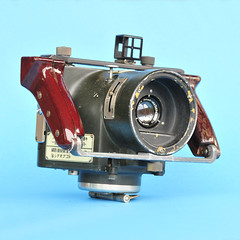 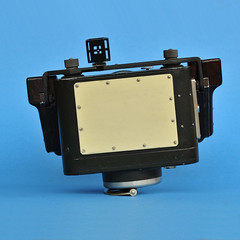  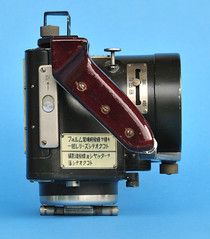 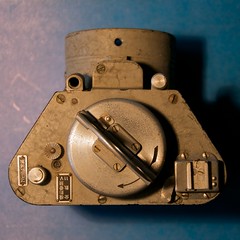
|
| Konishiroku-built Army Type 99 Ultra Small Aerial Camera (GSK-99). Pictures by Dirk HR Spennemann. (Image rights) |
Army Type 100 Small Aerial Camera (SK-100)
The Army Type 100 Small Aerial Camera (SK-100) is a hand-held aerial camera, introduced in 1940.[22] It seems that it was mainly produced by Konishiroku. The US report already cited above gives detailed production figures for the cameras built by Konishiroku in the 1941–1945 period:[23]
| Year | 1941 | 1942 | 1943 | 1944 | 1945 | Total |
| Ordered | 233 | 400 | 2500 | 1400 | 1600 | 6133 |
| Delivered | 30 | 306 | 1456 | 2212 | 265 | 4269 |
At least some SK-100 cameras were also produced by Chiyoda Kōgaku[24] (predecessor of Minolta) or by Katsura Seisakusho.[25] Some sources insist in attributing the SK-100 to Chiyoda altogether, but it rather seems that the camera was developed by Konishiroku,[6] drawing on its longer experience of aerial cameras, and that the other manufacturers played a secondary role.
The SK-100 takes fourty 11.5×16cm pictures[26][27] on special rollfilm, 18cm wide and 6m long.[23] The camera is much larger than the GSK-99 — its dimensions are 38×29×35cm, and it weighs 6.9kg.[26] There is a built-in focal-plane shutter, giving 1/200, 1/300 and 1/400 speeds.[26][27][24]
The camera has a folding frame finder at the top, and large handles on both sides of the body. There is a retractable bubble level, for vertical photography.[28] The main release is a trigger, falling under the right-hand index.
The shutter is of the focal-plane type, with vertically running curtains. It gives 1/200, 1/300 and 1/400 speeds,[26][27][24] set by a small button placed at the bottom right of the camera. On some cameras, the selected speed is displayed in a small window on the rear, behind this button, with the indication 露出速度 ("exposure speed").[28] The slit between the two shutter curtains has a fixed width, and the speed button actually modifies the tension of the main springs.[29] It is said that the slit is constantly open, and that a light shield is raised behind the lens after each exposure, in order not to fog the film.[25]
The camera's back is removable for film loading. The supply spool is inserted at the bottom, and the film runs from bottom to top.[29] There is a glass plate inside the exposure chamber, behind the shutter curtains, to improve the film flatness. The film is advanced and the shutter is wound by turning a large knob on the right. The frame number is displayed on the rear, behind the knob, sometimes with the indication 撮影枚數 ("frame number").[28]
There is an electrical connector on the side of the front barrel, to supply electrical power to two heating resistors built inside the camera, to prevent freezing at high altitude.[29]
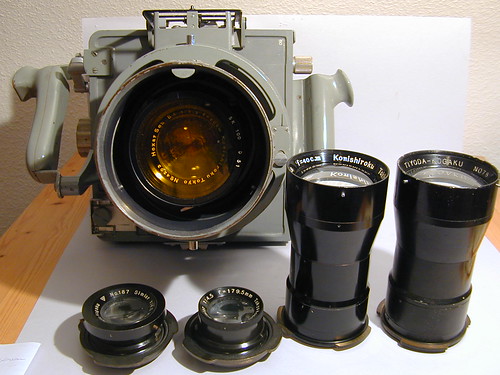
|
| Army Type 100 Small Aerial Camera (SK-100), with Hexar Ser.IIA 20cm f/3.5 no.4203. The other lenses are Simlar 180.2mm and 179.5mm f/4.5, Tele-Hexar and Boen Rokkor 40cm f/5.6. Picture by eBayer Hbpartner. (Image rights) |
The SK-100 takes interchangeable lenses via a large bayonet mount with three lugs. The most common standard lens is the Konishiroku Hexar Ser.IIA 20cm f/3.5; other known standard lenses are the Rokkor 20cm f/4.5[30] by Chiyoda Kōgaku, the Simlar 180mm f/4.5 by Tōkyō Kōgaku (engraved with the exact focal length, i.e. 179.5mm or 180.2mm),[31], the Zuiko 200mm f/4.5 by Takachiho and the 20cm f/4.5 Aero-Nikkor by Nippon Kōgaku. Konishiroku and Chiyoda Kōgaku also made 40cm f/5.6 telephoto lenses for the camera, respectively called Tele-Hexar and Boen Rokkor.[32] (Various sources mention a Rokkor 50cm f/5.6 instead of the 40cm f/5.6, but this is perhaps a confusion.)[33]
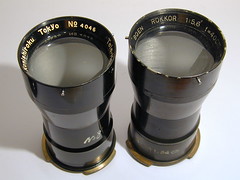 
|
| Tele-Hexar 40cm f/5.6 lens no.4046 and Boen Rokkor 40cm f/5.6 no.78, for SK-100. Pictures by eBayer Hbpartner. (Image rights) |
All the lenses for the SK-100 have three prongs at the front, to attach a filter. Various filter types exist; all are engraved SK 100 on the rim.
Konica Type G Aerial Camera
To be done.
Miscellaneous imported cameras
The Japanese first imported Nedinsco FK I hand-held aerial cameras, described above, and later Fairchild F-8 and K-8, which were used in some quantity before switching to locally produced copies.[34] It is also said that a few Fairchild K-14 bought from the U.S. were used at night with aluminium-magnesium flare bombs.[35] A few Rb75 and Rb50 mapping cameras were also bought to Germany, but they were deemed too large for use in Japanese aircraft.[36]
Fixed reconnaissance cameras
The Fixed Aerial Camera K-8 type (固定式航空写真機K-8型) was made for the Japanese Navy by Rokuoh-sha, later Konishiroku.[5][7] It was a copy of the Fairchild K-8, of which some examples were bought before the outbreak of the Pacific War.[23] The production figures for the 1941–1945 period were as follows:[5]
| Year | 1941 | 1942 | 1943 | 1944 | 1945 | Total |
| Ordered with 50cm lens | _ | 30 | 100 | 500 | 600 | 1230 |
| Delivered with 50cm lens | _ | 0 | 108 | 378 | 89 | 575 |
| Ordered with 25cm lens | 10 | 10 | 25 | 383 | 480 | 908 |
| Delivered with 25cm lens | 10 | 10 | 15 | 202 | 79 | 316 |
The camera takes 18×24cm pictures[37][7] on film rolls 24cm wide and 24m long,[11] allowing for 100 exposures[7] and loaded in interchangeable magazine backs. It is equipped with a leaf shutter. The camera is remotely controlled and needs 12V electrical power supply.[23]
The camera was available in two main versions, differing by the lens unit. One has a 50cm f/5 lens (presumably a Hexar) and 1/50 to 1/100 speeds, for vertical pictures taken at altitudes from 20,000 to 30,000 feet.[23] The other has a Perigon[7][38] 25cm f/4.5 and 1/50 to 1/150 speeds, for use at altitudes from 13,000 to 23,000 feet.[37] (The name Perigon certainly indicates that this is a wide field lens.) Both versions were used in the C6N Saiun (Myrt) reconnaissance plane.[23][37] A special mount grouping together three 25cm K-8 at vertical and oblique angles was tested but apparently not operationally used.[37]
The complete 50cm K-8 set consists of the main camera with lens unit and film magazine, two spare magazines, two intervalometers, an optical sight and a repair kit.[23][39] Various outfits are pictured in the 1945 American report cited above,[40] and a 25cm K-8 with Perigon lens and airframe mount is displayed at the Smithsonian National Air and Space Museum.[41]
Army No.1 Automatic Aerial Camera 25cm
To be done.
Army New Type Automatic Aerial Camera
To be done.
Machine-gun training cameras

|
| Top: Katsura Seisakusho Machine Gun Training Camera bottom: Rokuoh Sha Type 89 Machine Gun Training Camera image by Dirk HR Spennemann (Image rights) |
Machine-gun training cameras are shaped as a machine gun, and are used to train the gunners. Rokuoh-sha made various such cameras from the mid-1920s onwards, and Tōkyō Kōgaku made at least one model in the late 1930s. These "machine guns" shot photos of targets instead of shooting bullets onto the targets for documentation of a new machine gunner's training success.
The Type 15 Gun Camera with Watch (一五式写真銃時計附)[42][43] was made by Rokuoh-sha for the Navy, and the Type 15 Gun Camera Modified 1 (一五式写真銃改一)[44] was certainly an evolution.
This machine-gun camera was ordered in May 1925 by Yamada Kōgorō (山田幸五郎) of the Japanese Navy, was produced from 1926 under the supervision of Mōri Hirō (毛利広雄), and delivered from 1927.[44] It was inspired by the Hythe gun camera made by Thornton-Pickard in Great-Britain from 1915,[42][44] itself based on the Lewis machine gun. The Japanese copy was initially equipped with Wollensak or Zeiss Tessar lenses.[44] It is said that it was produced until 1942,[44] certainly switching to Japanese lenses at some point.
The camera takes 120 size rollfilm, and reportedly makes 4×4.5cm exposures, with target rings superimposed on the image.[42] The time is recorded on the rest of the 6×6cm frame[42] via a secondary lens on the side, taking pictures of a watch dial placed under the front bead. The camera has no sequential firing ability, and the frames are advanced by a spring motor one by one.[43] The gun camera normally has a drum magazine at the top, only used to enhance the similarity with the Lewis machine gun.[43]
Army Revolving Target-checking Camera
The Revolving Target-checking Camera (廻転式射撃鑑査写真機) was a similar camera made by Rokuoh-sha for the Army.[45][44] (In the name, the word "revolving" either refers to the drum magazine mounted at the top or to the fact that the camera was mounted on a turret.) The camera was also called "Hythe type" (ハイス型),[46] after the original Thornton-Pickard's Mk. III Hythe Camera Gun of 1916 of which it was a copy.[47] It has almost the dimensions of a Japanese type 92 machine gun for calibre 7.7mm,[48]
This model was perhaps released around 1926, at the same time as the Type 15 for the Navy. The image size is 4.5×6cm on 120 film,[45] and there is no time recording device. It is said that the early cameras have Wollensak or Zeiss Tessar lenses.[44] Later ones have an Optor or Topcon Toko 28.5cm f/11 lens.[45][49]
The same camera was also made by Katsura (see image) as well as Tōkyō Kōgaku, which supplied almost 900 units to the Japanese Army.[50] The version made by this company is called "Model 17" in some recent sources, but this is perhaps a confusion with the serial number of a surviving camera.[51] One source mentions a 387.5mm f/11 fixed-focus lens, but the focal length is perhaps wrong.[52]
The Type 89 Moving-image Machine-gun Camera (八九式活動写真銃) was an all new model by Rokuoh-sha. It is said that four experimental cameras were made in 1929.[44] (In the name, "Type 89" stands for year 2589 in the Japanese mythological calendar, i.e. 1929.) That early version perhaps had imported lenses. The improved Type 89 Moving-image Machine-gun Camera Kai (八九式活動写真銃改) or "Kai 1" (改一) followed in 1931 with Hexar lenses.[44] The final version was the Kai 2 (改二), serial produced from 1933 to about 1944.[44] The camera was used by the Navy,[53] as indicated by the anchor usually stamped on the nameplate.[54]
The production figures for the 1941–1945 period were as follows:[5]
| Year | 1941 | 1942 | 1943 | 1944 | 1945 | Total |
| Ordered | 1320 | 1500 | 600 | — | — | 3420 |
| Delivered | 941 | 1506 | — | — | — | 2447 |
The camera takes 18×24mm target pictures through the main lens and the time measured by a Seikosha stop watch through an auxiliary lens.[53] on 35mm cine film loaded in 2.5m strips.[55][56] It is driven by a spring motor, and can take sequences at 10 frames per second.[53] The taking lens is a Hexar Ser.1 7.5cm f/4.5, and the firing time is recorded via a Hexar Ser.1 4cm f/4.5 auxiliary lens aimed at a stop watch dial.[44][53] The optical sight, handgrip and attachment lugs are removable, and minor variations may exist.[57]

|
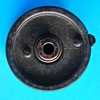 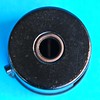  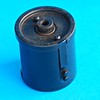 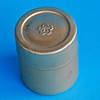 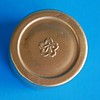
|
| Film cassette for the Type 89 Machine-gun Camera. Pictures by Dirk HR Spennemann. (Image rights) |
Fixed target cameras
Target cameras are attached inside or outside the aircraft, and are able to shoot a rapid sequence of images to document the result of a combat action or for training purpose.
Attached outside the aircraft
The Fixed Target-checking Camera (固定射撃鑑査写真機)[58] was patterned after the profiled gun camera made by the French company OPL. It was also called "Levallois type" (ルバロア型),[59] certainly for that reason (OPL is "Optique de Précision de Levallois"). The camera is contained in an aerodynamic fairing, attached outside the aircraft under the fuselage or wings. It takes 4.5×6cm exposures on 120 film, and has a single shutter speed.[60]
At least some examples were made by Tōkyō Kōgaku, and have a Toko 35.6cm f/4.5 fixed-focus lens.[61] It is said that they were issued in 1941 and used by the Navy on the Zero fighter;[62] however the camera looks older and it is likely that the Zero had more modern gun cameras mounted inside the wings (see below).

|
| Rokuoh Sha Type 1 Fixed Target-checking Camera image by Dirk HR Spennemann (Image rights) |
Fitted inside the wings or fuselage
Rokuoh-sha made various cameras, mounted inside the aircraft wings.[55]
- The Type 1 Fixed Target-checking Camera (一式固定射撃鑑査写真機), for the Army, takes 35mm film and was produced in two variants, first with a Hexar Ser II f/3.5 75mm[63] and later with an Optor 75/3.5 lens.[55]
- The Type 2 Fixed Target-checking Camera (二式固定射撃鑑査写真機) is shaped as a machine gun, and takes 16mm film cartridges akin to bullet magazines.[55] It was also made for the Army from 1942 to the end of the war.[55]
- The Type 2 Moving-image Machine-gun Camera (二式活動写真銃) is another gun camera made for the Navy from 1942, reportedly used in the Zero fighter.[64] It is unclear if it takes 16mm or 35mm film.[65] It has a Hexar 45/2, and takes 300 shots at 12 frames per second.[7]
Notes
- ↑ 1.0 1.1 1.2 1.3 25cm Aerial Camera (Nedinsco type) at Wetwing Aerial Camera.
- ↑ 2.0 2.1 Handheld Aerial Camera 25cm (archived) at Kore Nāni.
- ↑ Japanese Naval Photography, p.12, where the camera is described as the "25cm Hand-Held Oblique Camera".
- ↑ Pictures in this page (archived) at Kore Nāni.
- ↑ 5.0 5.1 5.2 5.3 5.4 5.5 5.6 5.7 5.8 Japanese Naval Photography, p.8.
- ↑ 6.0 6.1 6.2 6.3 6.4 6.5 6.6 Aerial camera types at Wetwing Aerial Camera.
- ↑ 7.0 7.1 7.2 7.3 7.4 7.5 7.6 7.7 Iwama, pp.55 of Kurashikku Kamera Senka no.10.
- ↑ Japanese Naval Photography, p.7.
- ↑ 1924 to 1938: Aerial camera types at Wetwing Aerial Camera. 1925 to 1938: Iwama, pp.55 of Kurashikku Kamera Senka no.10.
- ↑ 10.0 10.1 10.2 Japanese Naval Photography, p.10, repeated in this page at Airrecce (archived)
- ↑ 11.0 11.1 11.2 Japanese Naval Photography, p.18.
- ↑ Iwama, p.55 of Kurashikku Kamera Senka no.10, says 6m, but this is certainly a confusion with the 18cm × 6m rolls used in some Army cameras, see Japanese Naval Photography, p.18.
- ↑ Examples pictured in this WorthPoint entry (with Rokuoh-sha Tokyo Hexar Ser.1 25cm f/4.5 lens no.5382), and in this page and this page at Wetwing Aerial Camera (with serial no.1176).
- ↑ Examples pictured in this page (archived) at Airrecce, and in F-8 this page (archived) of the NASM.
- ↑ Iwama, p.54 of Kurashikku Kamera Senka no.10, this page at Wetwing Aerial Camera, and Japanese Naval Photography, p.11, all say 7.5×10cm. This page (archived) at Kore Nāni says 70×100mm, and Sugiyama, item 6010, says 72×98mm.
- ↑ The camera pictured in this page (archived) at Kore Nāni clearly shows an exposure counter graduated from 1 to 20. Japanese Naval Photography, p.11, repeated in this page (archived) at Airrecce, also mentions 20 exposures. This page at Wetwing Aerial Camera, mentions 6 or 10-exposure film strips, perhaps by mistake. Sugiyama, item 6010, says that the camera takes glass plates and sheetfilm, but this is obviously a mistake.
- ↑ This page (archived) at Kore Nāni, and specifications in Sugiyama, item 6010.
- ↑ Japanese Naval Photography, p.11, repeated in this page (archived) at Airrecce.
- ↑ This page (archived) at Kore Nāni.
- ↑ Compare the two examples pictured in Iwama, p.54 of Kurashikku Kamera Senka no.10.
- ↑ "Type 99" stands for year 2599 in the Japanese imperial calendar, i.e. 1939.
- ↑ "Type 100" stands for year 2600 in the Japanese imperial calendar, i.e. 1940.
- ↑ 23.0 23.1 23.2 23.3 23.4 23.5 23.6 Japanese Naval Photography, p.9.
- ↑ 24.0 24.1 24.2 Sugiyama, item 6013.
- ↑ 25.0 25.1 This page of the Topcon Club.
- ↑ 26.0 26.1 26.2 26.3 Kurashikku Kamera Senka no.12, p.18.
- ↑ 27.0 27.1 27.2 Francesch, p.253.
- ↑ 28.0 28.1 28.2 Pictures in Type 100 Small Aerial Camera (archived) at Kore Nāni.
- ↑ 29.0 29.1 29.2 Type 100 Small Aerial Camera (archived) at Kore Nāni.
- ↑ Example pictured in Sugiyama, item 6013.
- ↑ Examples pictured in this article.
- ↑ Examples pictured in this article.
- ↑ The Rokkor 50cm f/5.6 is mentioned in Sugiyama, item 6013, in Kurashikku Kamera Senka no.12, p.18, in Francesch, p.253, and in this page by Dennis Lohmann. All these sources list two lenses only for the SK-100: the 20cm f/4.5 and the "50cm" f/5.6, and none mentions the 40cm f/5.6.
- ↑ Japanese Naval Photography, pp.7 and 9.
- ↑ Japanese Naval Photography, p.31.
- ↑ Japanese Naval Photography, p.12.
- ↑ 37.0 37.1 37.2 37.3 Japanese Naval Photography, p.10.
- ↑ Example pictured in this page (archived) of the NASM.
- ↑ A full set is pictured in Iwama, p.55 of Kurashikku Kamera Senka no.10.
- ↑ Japanese Naval Photography, pp.57–60.
- ↑ this page (archived) and this page (archived) of the NASM.
- ↑ 42.0 42.1 42.2 42.3 Sugiyama, item 6014.
- ↑ 43.0 43.1 43.2 Nakayama and Imai, pp.126–7 of Militarī gun'yō kamera daizukan.
- ↑ 44.00 44.01 44.02 44.03 44.04 44.05 44.06 44.07 44.08 44.09 44.10 This page at R.Konishi Rokuoh-sha. The page mentions a batch of four, followed by another batch of ten, but there were surely others.
- ↑ 45.0 45.1 45.2 Sugiyama, item 6018.
- ↑ Label inside the original box, observed in a picture posted at a forum.
- ↑ Iwama, p.54 of Kurashikku Kamera Senka no.10, mentions a "Hythe model Target-checking Camera" (ハイス型射撃鑑査写真機) for the Navy. This is probably a confusion between the Army's Revolving Target-checking Camera and the Navy's Type 15 Gun Camera.
- ↑ see pinterest museum picture and WWII picture
- ↑ Example pictured in this page (archived) at Seawood Photo.
- ↑ Sugiyama (item 6016_ notes 605 units, but recorded serial numbers go as high as 892.
- ↑ The camera is called "Model 17" in Sugiyama, item 6016, but the Japanese text actually corresponds to a serial number (第十七号), certainly that of the pictured example. Antonetto and Russo, pp.25 and 196, repeat the name "model 17", certainly after Sugiyama; they say that this was a "rapid-firing camera capable of shooting a burst of 4.5×6cm frames", but this is unconfirmed.
- ↑ Antonetto and Russo, p.196.
- ↑ 53.0 53.1 53.2 53.3 Sugiyama, item 6015.
- ↑ Many of these cameras were acquired by U.S. soldiers in Japan and consequently they are quite frequently offered in on-line auctions
- ↑ 55.0 55.1 55.2 55.3 55.4 Iwama, p.54 of Kurashikku Kamera Senka no.10.
- ↑ Seikosha stop watch from a Type 89 machine gun camera on uhrforum [1]
- ↑ Minor variations are reported between the two examples pictured in Nakayama and Imai, pp.124–5 of Militarī gun'yō kamera daizukan.
- ↑ The name is given in this page of the Yokohama Radio Museum. It is called "Zero Fighter Target-checking Camera" (固定射撃鑑査銃, literally "Fixed Target-checking Gun") in Sugiyama, item 6017.
- ↑ This page of the Yokohama Radio Museum.
- ↑ Sugiyama, item 6017.
- ↑ Sugiyama, item 6017, repeated in Antonetto and Russo, p.196.
- ↑ Sugiyama, item 6017, repeated in Antonetto and Russo, p.25. The latter source says that the camera was relatively similar to the preceding "Model 17" machine-gun target-checking camera, but this is a confusion and the two cameras are very different in shape.
- ↑ The lens bezel states "Rokuoh Sha Tokyo" Photograhica Collection Dirk HR Spennemann
- ↑ Iwama, pp.54–5 of Kurashikku Kamera Senka no.10.
- ↑ Iwama, pp.54–5 of Kurashikku Kamera Senka no.10, mentions 16mm film in the text but 2.4×3.6cm frame size in the picture caption.
Bibliography
- Antonetto, M. and Russo, C. Topcon Story. Lugano: Nassa Watch Gallery, 1997. ISBN 88-87161-00-3. P.25.
- Iwama Tomohisa (岩間倶久). "Konica history 8. Konishiroku no gun'yō kamera." (Konica history 8. 小西六の軍用カメラ. Konishiroku military cameras.) Kamera Rebyū: Kurashikku Kamera Senka (カメラレビュー クラシックカメラ専科) / Camera Review: All about Historical Cameras no.10, September 1987. No ISBN number. Konishiroku kamera no rekishi (小西六カメラの歴史, special issue on Konishiroku). Pp.54–5.
- McKeown, James M. and Joan C. McKeown's Price Guide to Antique and Classic Cameras, 12th Edition, 2005-2006. USA, Centennial Photo Service, 2004. ISBN 0-931838-40-1 (hardcover). ISBN 0-931838-41-X (softcover). Pp.538, 545 and 673–4.
- "Minoruta no gun'yō kamera" (ミノルタの軍用カメラ, Minolta military cameras). Kamera Rebyū: Kurashikku Kamera Senka (カメラレビュー クラシックカメラ専科) / Camera Review: All about Historical Cameras no.12, October 1988. No ISBN number. Minoruta kamera no subete (ミノルタカメラのすべて, special issue on Minolta). P.18.
- Nakayama Kaeru (中山蛙) and Imai Kesaharu (今井今朝春). Militarī gun'yō kamera daizukan (ミリタリー軍用カメラ大図鑑, Album of military cameras). Tokyo: Green Arrow, 1997. ISBN 4-7663-3192-3.
- Sugiyama, Kōichi (杉山浩一); Naoi, Hiroaki (直井浩明); Bullock, John R. The Collector's Guide to Japanese Cameras. 国産カメラ図鑑 (Kokusan kamera zukan). Tokyo: Asahi Sonorama, 1985. ISBN 4-257-03187-5. Items 6010–18.
- U.S. Naval Technical Mission to Japan. Aeronautics Targets. Japanese Naval Photography. Index No. A-39. Report dated Dec. 20, 1945. Available in pdf format.
Links
In English:
- Japanese aerial cameras at Airrecce (archived)
- Japanese aerial cameras in the collections of the Smithsonian National Air and Space Museum:
- F-8 type (made by Rokuoh-sha, with Hexar.1 25cm f/4.5 lens)
- K-8 type (made by Konishiroku, with Perigon 25cm f/4.5 lens) and airframe mount
- Kugisho experimental
- Automatic No.1 Type 2 (made by Nippon Kōgaku, with Aero-Nikkor 50cm f/5.6 lens)
- Type 4 (oblique camera made by Rokuoh-sha, with Hexar 50cm lens)
- Type 1 (mapping camera made by Tōkyō Kōgaku, with Tele-Simlar 40cm f/5 lens)
- Flak spotting (periscope camera made by Asahi Denki, with Hexar 30cm lens)
- Fixed Target-Checking Camera Model 2 (made by Tomioka)
- Type 100 Small Aerial Camera (SK-100) at Oddity Cameras
- Machine-gun cameras at Seawood Photo, showing a Revolving Target-checking Camera and a Type 89 Machine-gun Camera Kai 2
- Type 89 Machine-gun Camera Kai at MyConfinedSpace
- "Nikon and the sponsorship of Japan's optical industry by the Imperial Japanese Navy, 1917-1945", by Jeff Alexander, published in Gateway
- Past sales by Westlicht Photographica Auction (now Leitz Photographica Auction):
- Type 89 Machine-gun Camera Kai 2: lot no.609 of the fourth auction (November 22, 2003)
- Konica Aerial Type G: lot no.713 of the eleventh auction (May 26, 2007)
- Past auctions by LP Foto:
- Konica Aerial Type G: lot no.96 and lot no.97 of auction no.18 (April 27, 2003)
- Konica Aerial Type G: lot no.86 of auction no.24 (April 22, 2006)
- Konica Aerial Type G: lot no.100 of auction no.28 (December 9, 2007)
- Konica Aerial Type G: lot no.79 of auction no.29 (March 16, 2008)
- Konica Aerial Type G: lot no.115 of auction no.31 (November 2, 2008)
- Konica Aerial Type G: lot no.316 of the March 25, 2006 Photographica and Film auction by Auction Team Breker
In Japanese:
- Wetwing Aerial Camera, with the following subpages:
- Pages at Kore nāni (archived):
- Handheld Aerial Camera 25cm (Nedinsco type) (archived)
- Type 99 Handheld Aerial Camera 15cm (archived)
- Type 100 Small Aerial Camera (SK-100) (archived)
- Type 100 Small Aerial Camera (SK-100) among other cameras in the Topcon Club website
- Pages at Miliken's blog:
- Type 89 Machine-gun Camera Kai 2 at Aiki Ainichi
- Hexar Ser.1 7.5cm f/4.5, perhaps for the Type 89 Machine-gun Camera, at Aho Ressha Pictorial
- Japanese aerial cameras at the Yokohama radio museum, with pictures of an Automatic Aerial Camera Mark 1 Model 2, of a Fixed Target-checking Camera (type Levallois), and of a Type 1 Fixed Target-checking Camera
- Rokuoh-sha lenses at R. Konishi Rokuoh-sha, with information on the company's aerial cameras
